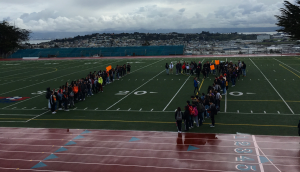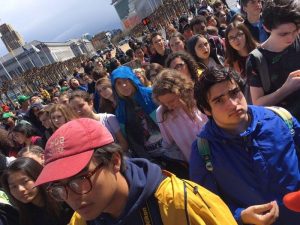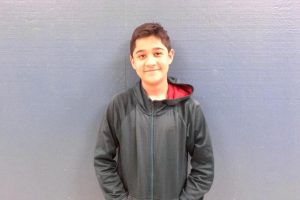Stories Get Personal at KALW When Reporting on March 14 National School Walkout
By Ben Trefny, News Director, KALW Public Radio
It’s been quite a while since I’ve sent a blog, but it’s not for lack of goings on at KALW! In fact, I plan to post several in the next few weeks to give some highlights of the work being done by people in our Audio Academy and other training programs.
To that point, today I want to talk about a Crosscurrents show we aired on Wednesday, March 14th. We covered the national school walkout, and we put some creative thought into what content would contribute value to the conversation.
For the first time, we put a direct call out to high schoolers to hear what they thought would help keep them feeling safe in schools. We purposefully wanted to keep that concept broad, because safety for many kids goes well beyond concern of random mass murders by lone gunmen – it is an everyday occurrence that could involve bullying, gangs, ostracism, or any number of other unresolved issues.
A teacher at Richmond High School decided to take our request and turn it into an assignment for her students. The result is this piece, and this one, this one along with this poem which made it to our broadcast. It’s wonderful, and critical, to hear young voices, particularly around this issue, and I think we’ll make a habit of calling out for youth contributions.
Also, I visited San Quentin State Prison with our team of editors at the end of February for a training session. Our conversations there with the San Quentin Radio reporters often turn to current events, and on that day, we talked about the murders in Parkland. It turned out the guys we work with had many thoughts, and a lot to say about safety and support in schools, generally. We decided that it could be powerful to hear the voices of incarcerated men speaking about gun control, access to guns, inclusion, exclusion, counseling, and other topics related to what helps kids thrive. Reporter Greg Eskridge put the work in, and he produced this piece, which aired in our show on March 14th.
Finally, I talked with two of our Audio Academy fellows, Zeina Nasr and Asal Ehsanipour, about covering the walkout that morning, carefully recording and categorizing sounds of the action and participants, and then bringing it back for our crew to work with and embed into a question and answer session to air later that day. I envisioned it as being something like the popular New York Times podcast The Daily, but featuring members of our Audio Academy. How did it come out? Hear for yourself by clicking here! And then continue on to read Asal’s recounting of the day’s work.
Here’s what she had to say:
Wednesday, March 14, marked one month since the shooting in Parkland, FL which killed 17 people at Stoneman Douglas High School. To commemorate the tragedy and build momentum on a movement against gun violence, the students in Parkland called on high school students across the nation to band together for a walkout.
I reported on the event here at San Francisco’s Phillip & Sala Burton High School, where KALW studios are located. Though I frequent Burton’s halls, hear the students laughing between periods, and catch brief glimpses of their classes, the students and I have minimal interaction. So, when I arrived on Wednesday morning, I surprisingly had no clue where to go. It was as if I was reporting on a high school I’d never stepped foot in. After a brief conversation with Ben and with my recorder in hand, I made my way through the faculty parking lot hoping I’d somehow end up where I needed to be.
Students were still in classes, as the walkout hadn’t yet begun. I’m lucky that Sam Bass, Burton’s principal, caught me loitering and directed me to the field where the high schoolers were planning to gather. After agreeing for an interview after walkout, Principal Bass said that the students intended to form a number 17 on the field, in honor of the 17 slain in Parkland. “They have great ideas,” he said, but suspected implementation would fall short.

Students at Burton High School form the number 17 on the football field to commemorate the 17 people killed at Douglas High School in Parkland, Florida. Photo Credit: Asal Ehsanipour.
But, when I made my way outside, dozens of students were already forming the shell of a “17.” The bell rang and advisory began. Students poured out of classrooms, creating a more robust “17” every minute. I did my best to blend in as I gathered the sounds I needed, like students reacting to the walkout or Patricia Fong yelling into the megaphone to rally her peers. I stayed for the rest of the event, which included over 200 students walking out of Burton High School to march in silence with 10-15 other high schools toward City Hall. Reporting on the event felt like scrambling to be everywhere while trying to stay invisible.

High school students from throughout San Francisco converge at City Hall. Photo Credit: Kyle Trefny.
The biggest challenge I faced during this reporting assignment was crossing every item off my checklist: gathering sound that transport listeners into the space, collecting interviews with students and faculty, taking photos to illustrate the event, noting time stamps to make isolating tape easier. Being the only reporter at a scene takes multitasking and the aptitude to swiftly toggle between tasks. It’s possible to do, but not without wishing I had a third hand to help hold my recorder, iPhone, pen and notepad at the same time.
After collecting my sound, I rushed back to the studio and immediately listened through my tape. I also kept an ear out for what Ben calls “sweeteners,” which are exciting moments within the ambient sound. Then I reviewed my notes, as Zeina and I were about to record an unscripted Q&A with Crosscurrents host Hana Baba about what we’d seen. Of course, there was pressure to get the facts right (and speak without my voice shaking). Thank all goodness, the Q&A was not live and there was room for some editing.
The next step was to incorporate our field reporting into the Q&A, which would then illustrate the story of the day as Zeina and I were telling it. With the help of Ben and our incredible engineers, James Rowlands and Gabe Grabin, Zeina and I were able to flip the story by airtime at 5pm. Full disclosure: I’m still in awe that we were able to do it! The experience was thrilling, challenging, and moving. Both professionally and personally, it meant a lot to me to be reporting on such a special event here in my own backyard. This assignment gave me hope for what’s possible. Yes, in terms of my growth as a reporter. But more importantly, it gave me hope for next generation.

